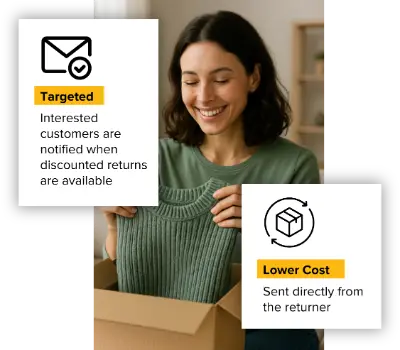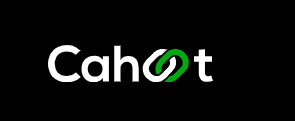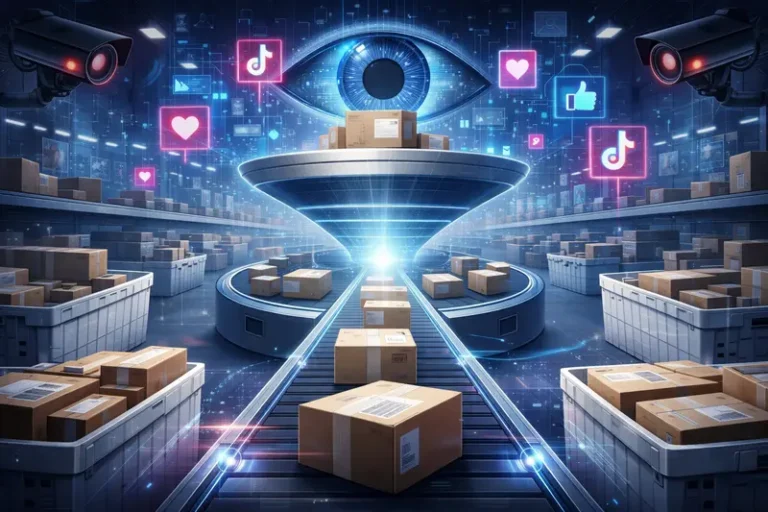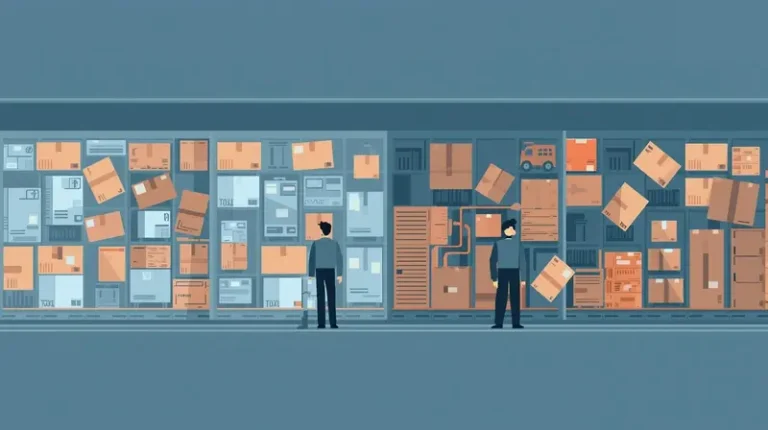Choosing a Fashion Ecommerce 3PL: Matching Size, Speed, And Seasonality

Last updated on August 29, 2025
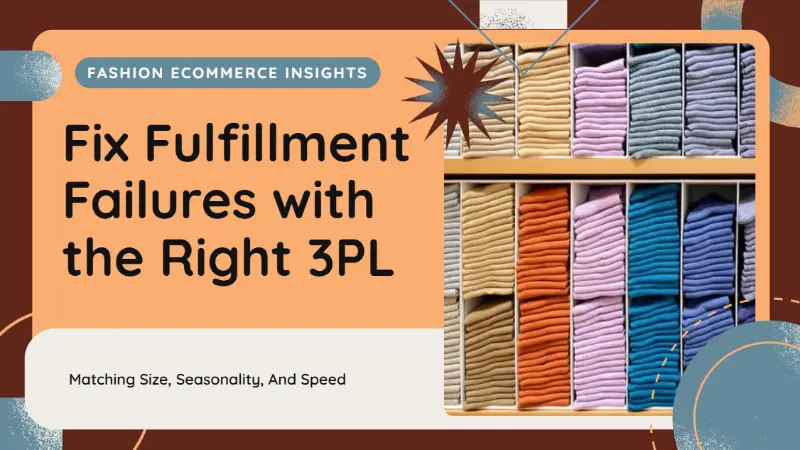
In this article
 11 minutes
11 minutes
- Introduction to Fashion Ecommerce
- The Fashion Reality Check for Fashion Brands
- Size, Seasonality, And Speed Drive Everything
- Technology in Fashion Ecommerce
- Returns Decide Your Margin
- Personalization in Fashion Ecommerce
- Twelve Questions I Ask In Every Fashion 3PL RFP
- Omnichannel Makes Or Breaks The Experience
- Sustainability And Packaging Without The Eye Roll
- Statistics and Trends
- What I Would Implement This Quarter
- Future of Fashion Ecommerce
- The Bottom Line
- Frequently Asked Questions
The fashion ecommerce industry has seen rapid growth, driven by technological advancements and innovative website experiences that help brands stand out in a highly competitive market. For fashion ecommerce sites, a clean design and intuitive navigation are essential to provide a seamless user experience and ensure that products and content stand out effectively. The global apparel market, encompassing both new and resale clothing, continues to expand, making fulfillment challenges even more critical for brands seeking to meet evolving consumer preferences. The rise of online shopping as the primary method for purchasing clothing and accessories has further accelerated these changes, increasing the pressure on brands to deliver seamless fulfillment experiences. But fashion ecommerce fulfillment is one of the hardest challenges in the industry. A wide range of ecommerce sites, from large marketplaces to niche platforms, play an essential role in the ecommerce landscape for fashion brands, driving growth and innovation. SKUs explode, size curves spike, returns flood, and every delay shows up on Instagram. The right 3PL can feel like oxygen. The wrong one eats your gross margin and your weekend. Here is how I evaluate a fashion ecommerce 3PL so brands keep speed, quality, and identity, and help your site stand out in the crowded fashion ecommerce space, without burning cash.
Slash Your Fulfillment Costs by Up to 30%
Cut shipping expenses by 30% and boost profit with Cahoot's AI-optimized fulfillment services and modern tech —no overheads and no humans required!
I'm Interested in Saving Time and MoneyIntroduction to Fashion Ecommerce
The fashion ecommerce industry is experiencing unprecedented growth, with the global ecommerce fashion market projected to soar to $1.6 trillion by 2030. Fashion brands and retailers are harnessing the power of ecommerce platforms to reach more customers than ever before, transforming the way people shop for clothing and apparel. In this highly competitive fashion ecommerce space, clothing brands and apparel brands are constantly innovating to capture the attention of today’s shoppers. The rapid growth of ecommerce fashion has made it essential for fashion retailers to create seamless omnichannel experiences, allowing customers to shop effortlessly across both digital and physical channels. Leading brands like ASOS and Zalando have set the standard, showing how a strong online presence and integrated shopping experiences can help brands stay ahead in the evolving world of fashion ecommerce.
The Fashion Reality Check for Fashion Brands
Fashion ecommerce is huge and still growing, driven by evolving trends in technology, consumer preferences, and social media influence. US online apparel is expected to pass two hundred billion dollars in 2025, with double-digit growth in some segments as consumers increasingly seek convenience, sustainability, and personalized experiences. The ecommerce fashion market continues to expand rapidly, reflecting significant shifts in market size and growth. Asia represents the largest market for fashion ecommerce, with apparel as the leading segment. To capture market share, it is crucial to position your business as a fashion brand or fashion retailer, leveraging industry-specific strategies and identity. Returns remain stubbornly high compared to other categories and are notably higher than in other industries, especially when customers bracket sizes, impacting overall purchases and sales performance. This is why your fulfillment partner matters more than ever. You need a team that speaks fashion, not just generic pick and pack.
Size, Seasonality, And Speed Drive Everything
1. Size curves and presentation: A good apparel 3PL understands that a small is not a small across brands, especially when handling clothing as the primary product type. You need allocation logic by size curve, clean folding, bagging, and, where required, garment-on-hanger for delicate pieces. Folding that shaves DIM weight without creasing is money in the bank. Different product categories, such as shoes and accessories, require tailored fulfillment approaches to ensure proper storage, packaging, and presentation. Incorporating a minimalist aesthetic in packaging and product presentation can enhance the unboxing experience and reinforce your brand identity. Additionally, ensure that product presentation and packaging are optimized for shoppers browsing on smaller screens, so visuals and information remain clear and appealing on mobile devices.
2. Seasonality and surge planning: Apparel is peaky. Capsules drop, promos hit, holidays spike. If the 3PL cannot staff quickly around those waves or pre-build kits for bundles, orders age and reviews tank. Ask for historical throughput and how they flex labor without sacrificing error rate.
3. Speed without chaos: Offering two-day or next-day selectively in key regions boosts conversion, but only if your 3PL has the nodes and the cutoffs. I like partners that show cutoffs by carrier and zip cluster on a simple board so ops can course correct daily. Quick delivery options can also encourage impulse purchases among online shoppers, driving additional sales through spontaneous buying decisions.
Technology in Fashion Ecommerce
Technology is at the heart of the modern fashion ecommerce industry, empowering brands to deliver personalized and engaging online shopping experiences. Fashion ecommerce websites are leveraging artificial intelligence (AI) and machine learning (ML) to provide tailored product recommendations, boosting customer engagement and driving more purchases. Social commerce and mobile commerce are also taking center stage, as shoppers increasingly use social media platforms and mobile devices to discover and buy the latest styles. Brands like Gymshark and Patagonia have embraced these trends, integrating social media and mobile commerce into their ecommerce strategies to connect with customers where they spend the most time. By adopting these technologies, fashion brands can create user-friendly websites that inspire shopping and make it easy for customers to find and purchase their favorite products.
Looking for a New 3PL? Start with this Free RFP Template
Cut weeks off your selection process. Avoid pitfalls. Get the only 3PL RFP checklist built for ecommerce brands, absolutely free.
Get My Free 3PL RFPReturns Decide Your Margin
Fashion returns can hit one in five orders or more. That makes reverse logistics your unglamorous superpower. Efficient returns processing is crucial for optimizing the customer’s purchase journey. When returns are handled quickly and smoothly, it encourages repeat purchases and builds loyalty. After a customer has purchased, targeted marketing and personalized product recommendations can further engage them, increasing retention and driving additional sales. The 3PL should process returns fast, grade condition accurately, steam or rebag where needed, and restock within forty-eight hours so you recover revenue and avoid contributing to landfill. I also want item-level defect codes so merchandising can kill or rework problem SKUs instead of arguing about vibes.
Personalization in Fashion Ecommerce
Personalization has become a cornerstone of success in the fashion ecommerce industry, as shoppers expect a unique and tailored experience every time they shop online. Fashion brands are using customer data and analytics to deliver personalized product recommendations, styling tips, and exclusive promotions, all of which contribute to a cohesive brand experience that fosters customer loyalty. By leveraging user-generated content (UGC) and social proof, brands can build trust and create a sense of community among their customers. For example, brands like Reformation and Nasty Gal have successfully used UGC and social proof to engage shoppers and encourage repeat purchases. Creating a personalized shopping journey not only enhances customer satisfaction but also helps fashion brands stand out in a crowded ecommerce market.
Twelve Questions I Ask In Every Fashion 3PL RFP
- What are your apparel-specific SLAs for on-time ship, order accuracy, and return cycle time?
- Do you support GOH, flat fold, size tagging, and value-add like hemming or steaming?
- How do you plan labor for drops and promos, and what is your peak error rate history?
- What is your average return-to-stock time by category?
- How do you minimize DIM weight for knits versus structured pieces?
- Can you integrate with my ecommerce platform, marketplaces, and store systems for omnichannel and leverage customer data for improved fulfillment and analytics?
- How do you support the creation and management of detailed product pages, including features like size guides, styling recommendations, and customer reviews?
- What are your east and west cutoffs by carrier, including Saturday and local courier options?
- How do you protect brand identity in packaging when you run multiple brands?
- What happens when a carrier lane degrades? Show me your playbook.
- How do you measure and reduce repeat returners and wardrobing abuse?
- Can your 3PL support personalized recommendations and product recommendations by utilizing customer data to enhance the shopping experience and drive engagement?
Omnichannel Makes Or Breaks The Experience
Most fashion brands need more than shipping from a warehouse. Seamless omnichannel experiences are now essential for fashion ecommerce brands, ensuring customers enjoy a consistent journey across all channels. Shopping online has become the preferred method for many consumers, making it essential for online retailers to provide consistent service across all channels. Store pickup and store returns, as well as shop pickup and shop returns, are standard now and serve as key touchpoints in the omnichannel journey. Your 3PL should push inventory to the right node, feed stores and shops with accurate availability, and support buy online, return in store or shop if that is part of your model. Customers feel the seams when this is bolted on. They reward brands that make it smooth.
Sustainability And Packaging Without The Eye Roll
Fashion audiences care about footprint, but they also care about unboxing. Offering a wide selection of sustainable packaging options can appeal to eco-conscious consumers and help differentiate your brand. Sustainable packaging solutions are especially appealing to consumers with modern lifestyles, who value convenience and eco-friendly choices. Your 3PL should offer recycled bags, right-sized boxes, and branded touches that are affordable. If the packaging team can swap components quickly, you can run tests without blowing up costs.
Statistics and Trends
The fashion ecommerce industry is shaped by powerful trends and compelling statistics. Mobile commerce now dominates, with 62% of fashion ecommerce transactions taking place on mobile devices, underscoring the need for mobile-optimized shopping experiences. Social commerce is also on the rise, with sales expected to surpass $1 trillion by 2028, highlighting the growing influence of social media on how consumers discover and purchase fashion. Sustainability is another key trend, as 72% of US consumers are now aware of environmental issues in the fashion industry and are seeking out eco-friendly and sustainable products. Major brands like H&M and Zara are responding by launching sustainable fashion lines and adopting greener practices throughout their supply chains. These trends are reshaping the ecommerce landscape, pushing brands to innovate and adapt to meet the evolving demands of today’s consumers.
What I Would Implement This Quarter
- A returns dashboard that shows restock speed, resale recovery, and reason codes by SKU, with push notifications to alert teams or customers about restock status.
- A size curve allocator that keeps the most popular sizes in the fastest nodes.
- A weekly lane review that compares ETA promises to actuals and flips carriers when needed.
- A clear rule for free returns by cohort, so you are generous for high LTV, firm with chronic abusers.
- A feature that showcases customer photos and styling tips to attract and engage potential buyers.
Scale Faster with the World’s First Peer-to-Peer Fulfillment Network
Tap into a nationwide network of high-performance partner warehouses — expand capacity, cut shipping costs, and reach customers 1–2 days faster.
Explore Fulfillment NetworkFuture of Fashion Ecommerce
Looking ahead, the future of fashion ecommerce is bright and full of opportunity. Fashion brands and retailers will need to stay ahead by embracing new technologies such as augmented reality (AR) and virtual reality (VR), which can create immersive and interactive online shopping experiences that captivate customers. As online shopping continues to evolve, brands must also prioritize sustainability and social responsibility, responding to consumers’ growing concerns about the environmental and social impact of their purchases. By leveraging these trends and technologies, fashion ecommerce brands can create engaging, future-ready shopping experiences that attract new audiences and build lasting customer relationships. Luxury brands like Gucci and Prada are already experimenting with AR and VR, setting the stage for the next wave of innovation in the fashion ecommerce industry. To stay competitive, brands must continue to innovate, adapt, and put the customer at the center of every shopping experience.
The Bottom Line
Fashion ecommerce is unforgiving, but not impossible. The right 3PL can provide a competitive edge in the market by optimizing fulfillment processes that help build trust and foster customer loyalty. Choose a 3PL that treats size curves, returns, and cutoffs like first-class citizens. Get the details right, and you will feel it in conversion, reviews, and cash. Miss them, and you are paying customers to leave.
Frequently Asked Questions
What Makes A 3PL Truly Fashion Ready?
Apparel-specific processes like GOH (Garment-On-Hanger), expert folding, rapid returns refurbishment, and size curve-aware allocation. Plus, real cutoffs and carrier agility.
How Fast Should A 3PL Process Returns?
Aim for forty-eight hours from receipt to restock with clear grading. Faster restock equals recovered revenue and fewer out-of-stock moments.
What Is The Right Speed Promise For Fashion Ecommerce?
Offer fast shipping selectively in regions where you can reliably hit the promise. Accuracy beats bravado every time.
How Do I Control Shipping Costs For Bulky Apparel?
Engineer packaging to drop DIM weight, pre-kit bundles, and route heavy items to the closest node. Carriers reward density and precision.
What 3PL Metrics Should We Watch Weekly?
On-time ship, order accuracy, return cycle time, restock recovery rate, and carrier lane performance. If those trend green, margin follows.
Turn Returns Into New Revenue
